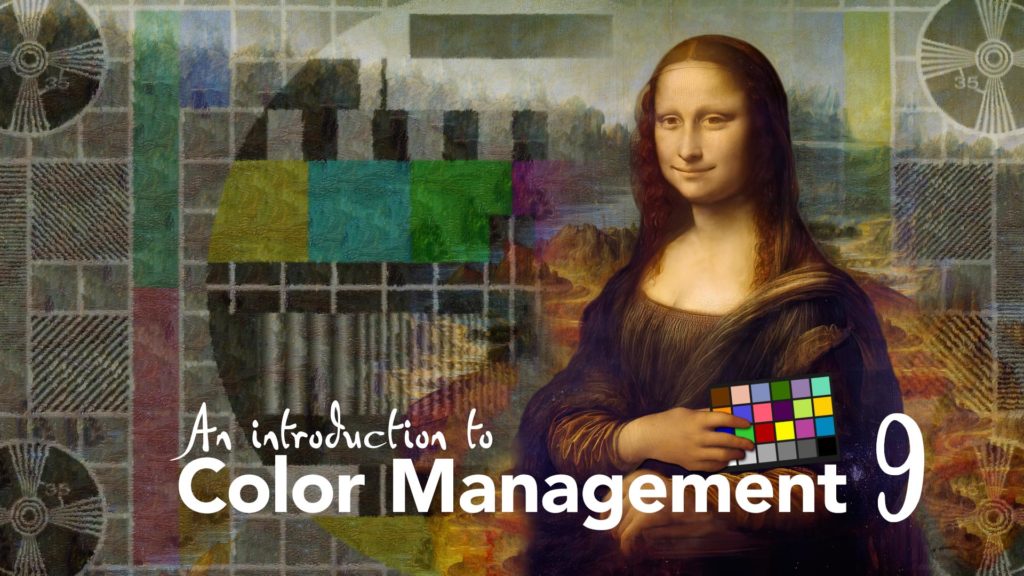The concept of a simple color managed workflow isn’t too difficult to understand. People working with video software are already used to dealing with assets that have different resolutions and frame rates. The colorspace of an image is just another attribute to be considered.
When you begin working on a video project, you always start with some basic technical requirements that include resolution and frame rate. If you’re using existing video assets, such as live action footage from a shoot or purchased stock footage elements, then they may or may not be the same as your project. But it’s no problem to include a range of sources that have different attributes together in one project. The same goes for color.
Although this series is aimed at After Effects users, the core principles of color management are universal. In this video, we’ll look at the general theory of a color managed workflow. In the next part in this series, we will look specifically at After Effects.
The first version of After Effects to include a full color management system was CS4, which was released in 2008. By this time, After Effects was already 15 years old, so it’s understandable that existing AE users didn’t feel the need to use color management just because it was there.
Before After Effects CS4 was released, the average After Effects user wasn’t exposed to many different colorspaces. This is why I referred to this time as a honeymoon period. Computers used sRGB, TVs used rec709, and they were very similar. Professional video cameras recorded in rec709. Consumer level cameras took photos in sRGB (the first iPhone was less than a year old). The Canon 5D mk2, the first DSLR that could record video, was only released in November 2008 and it recorded video in rec709. Everything was simple.
As explained in the video above, the point of a color managed workflow is that we assign our project a colorspace, and any assets which have a different colorspace are converted to match the project. But if every component in our workflow (assets, project, monitor and output) are the same, then no conversion will be needed. For a typical project in 2008, this would have been the case. If no color conversion is needed, then there’s no difference between having color management on or off.
And so people could get away without using color management, just as they had for the previous 15 years.
But, perhaps coincidentally, 2008 turns out to have been a significant year in the history of color management. Not only did After Effects launch version CS4, the first version of AE with a full color management system, but two highly influential products were emerging at the same time: the first RED camera, and the Canon 5D mk2.
RED were the first company to release a high-end, high resolution digital camera that didn’t just record video in rec709 colorspace. It really was a revolutionary product. The first RED camera, the Red one, was released in August 2007, but the software tools for working with digital R3D files were still emerging over a year later.
The idea that a digital camera could record images that weren’t rec709 was new. And RED had introduced something they called a RAW workflow, which was a radical departure from anything that had been done before. I’m not an expert on digital cinematography, but I do think it’s safe to say that RED started a revolution in digital cameras, and the changes that have occurred in the industry in the years since 2007 have been quite profound.
The Canon 5D mk2 was a revolution in a different way. Digital stills cameras had already existed for years, but they’d always been a completely separate product line to video cameras. But now Canon blurred the lines. The 5D mk2 became a hit with guerilla filmmakers and over the next few years most new DSLRs included the ability to record video. As the technology and market evolved, so did the sophistication of the products. Camera manufacturers introduced their own colorspaces and log formats to record video with a wider color gamut than rec 709.
Now, every camera manufacturer has their own line of professional digital cameras, and each manufacturer has developed their own range of colorspaces that can record a larger gamut than rec709.
In part 8, I suggested that it’s easier to understand what a colorspace is if we understand why we have different colorspaces. Now, I’m suggestion that it’s easier to understand why we need color managed workflows, if we understand that there are simply so many different colorspaces out there in common usage.
In 2008 anything that wasn’t either sRGB or rec709 would have been an unusual exception. But now, in 2022, there are almost too many colorspaces in common usage to list. And so the unusual exception these days might be working on a project that doesn’t have assets in more than one or two colorspaces.
So the basic components of a color managed workflow are pretty simple, and in the next part of this series we’ll look at After Effects and how it all works in practise.
This is part 9 in a long series on color management. If you’ve missed the other parts, you can catch up here:
Part 4: Maxwell’s spinning discs
Part 6: Understanding the CIE 1931 chromaticity diagram
Part 8: Introducing Colorspaces
AND – I’ve been writing After Effects articles and tutorials for over 20 years. Please check out some of my other ProVideo Coalition articles.

Filmtools
Filmmakers go-to destination for pre-production, production & post production equipment!
Shop Now













